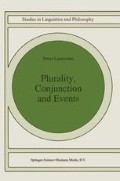Abstract
An especially interesting application of the semantics just sketched is in the analysis of a class of morphemes frequently encountered in the descriptive and diachronic literature, but only rarely and incompletely addressed in formal semantics. These morphemes normally take the form of some sort of affix on the verb, frequently reduplicative, most often derivational rather than inflectional, and expressing a broad range of notions typically including action by more than one individual, temporally iterated action, and spatially scattered action (among others). Morphemes of this type are common in the languages of North America and West Africa, and are also found in Dravidian languages, American Sign Language,1 and no doubt many other languages as well; despite their absence from the familiar European languages, they should not be considered particularly unusual or exotic.
Access this chapter
Tax calculation will be finalised at checkout
Purchases are for personal use only
Preview
Unable to display preview. Download preview PDF.
Notes
See, e.g., Fischer (1973).
There is a real need for a more standardized terminology for talking about pluractionality. Not only are several distinct terms in use, but some of these terms are used in very different senses by different authors. The term distributivity is especially subject to such variation: the difference between the formal semanticists’ use of this term and its use in descriptive work has already been mentioned, but in fact the meaning of this term is by no means uniform within either community Some linguists interpret distributive very narrowly, so that it always carries connotations of spatial scattering; others interpret it so broadly that one wonders whether the term retains any content at all. Cusic (1981), which represents probably the most detailed examination of pluractional markers, uses both the term dis-tributivity and the term verbal plurality,but not as synonyms; as discussed
below, he understands verbal plurality very broadly and treats distributivity as a special subcase.
Even aside from this condition, we should probably disqualify the empty set from counting a “group” of events, just as we did for individuals.
Several of Cusic’s terms here are drawn from Dressler (1968).
For completeness, Cusic also posits a fourth, highest level of histories,but makes no systematic use of it.
The distinction here is perhaps a little reminiscent of that between (ordinary) distributivity and “participatory” distributivity in Chapter 7.
The “internally or externally complex entity” which Cusic mentions, as well as its “separate bounded units,” will normally be events.
Or, in the case of the coordinated action and social accompaniment readings, through the use of functions mapping events onto a set of teams or parties.
Cusic notes that in transitive verbs, pluractional markers are more likely to express multiple objects than multiple subjects.
The fact that together was defined without reference to thematic roles while the participant-based readings of pluractional markers are defined with such reference makes the parallel less perfect than might be desired. Ultimately, we should consider recasting the definition of together in the neo-Davidsonian format suggested here. We will not bother to work through the details of such a recasting here, however.
Portions of this section are based directly on Blevins et al. (1990); it therefore represents joint work between myself and the other authors (especially Juliette Blevins), whose contributions I gratefully acknowledge. Responsibility for errors is my own, of course.
A camas is the edible root of Camassia esculenta,a variety of lily.
A likely difference is that (13.15)a. indicates that within the confines of each individual day, the action occurs repeatedly; while (13.17) means merely that the action occurs at least once per day. Barker is not completely clear on this point, however.
It is tempting to hypothesize that such a form might in fact be acceptable in a situation where some individual is ostracized independently by several distinct groups of people. Barker does not give enough detail to tell whether his informants considered such a situation.
Since Barker frames the restriction in terms of “actions performed by” animate or inanimate beings, I assume that it holds specifically for participants bearing the agent role, and not for other thematic roles. If this assumption is incorrect, certain details in the analysis below will have to be adjusted.
In (13.25), the variable X must be understood as ranging only over groups of events (i.e. sets of events of cardinality 2 or greater); otherwise we rule out even individual events with animate agents.
Author information
Authors and Affiliations
Rights and permissions
Copyright information
© 1995 Springer Science+Business Media Dordrecht
About this chapter
Cite this chapter
Lasersohn, P. (1995). Pluractional Markers. In: Plurality, Conjunction and Events. Studies in Linguistics and Philosophy, vol 55. Springer, Dordrecht. https://doi.org/10.1007/978-94-015-8581-1_13
Download citation
DOI: https://doi.org/10.1007/978-94-015-8581-1_13
Publisher Name: Springer, Dordrecht
Print ISBN: 978-90-481-4494-5
Online ISBN: 978-94-015-8581-1
eBook Packages: Springer Book Archive

